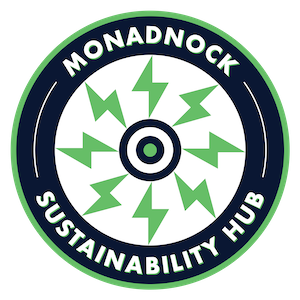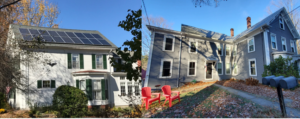by Gerald Burns, MSH Board member and Program Committee member.
Originally Published in The Monadnock Shopper News, Green Monadnock column, January, 2024.
The buzz of news coverage around the passage of the Inflation Reduction Act has long since died down. But the provisions of the law have been quietly coming into effect. They make available to Americans some $400 billion in incentives to reduce greenhouse gas emissions and save a great deal of money long-term, largely by transforming our energy use. What are these incentives, and how take advantage of them?
Before this question can be answered, it needs to be narrowed down. The IRA is a wide-ranging piece of legislation, offering opportunities to businesses, agriculture, utilities, native tribes, seacoast communities, and more. But a major beneficiary, likely to be familiar to readers of this publication, is households: big and small, low-income and high-, homeowners and renters. So let’s pick a few programs out of the many open to this group—truly, something for most everyone even if households are not a “special interest”—and sketch out enough details to see if they might be of interest to you.
Home Energy Audit. Not the biggest-ticket incentive, but a good place to start: a 30% up to $150 tax credit (TC) on the cost of a professional energy audit. This will lay the groundwork for future improvements. Apply for the credit by filling out IRS Form 5695 and entering the info into your 1040 (same procedure for all of the TC’s listed below except the last).
Weatherization. The next step could well be to weatherize your home. The IRA provides TC’s up to a total of $1,200 per year for insulation, external doors, windows, and skylights, among other upgrades. Although the total benefit for these purchases is modest, it is scheduled to be renewed annually for the next ten years, allowing households to accomplish many different upgrades and to map out a long-term plan for improving their energy profile.
Heat Pump. Chief among these upgrades, and in a category by itself for tax credit, is the heat pump. This is a single electric utility that can replace both a furnace and a central air conditioner; it is estimated to save between $650 and $1,000 a year on HVAC costs. The TC for the device sweetens the savings by $2,000, and the same amount is available for a heat pump water heater. And, although the details of implementation still need to be worked out, the law authorizes even more substantial heat-pump compensation for low- and middle-income households, to be paid as a rebate, outside the tax system.
Appliances. Incentives do now or will soon exist also for a range of high-efficiency appliances, including ENERGY STAR washers, heat-pump dryers, window AC’s, and induction stoves. Among other benefits, these appliances give renters a way to participate in the savings and the energy transition that the IRA promotes.
Home solar. The new law also covers energy generation: 30% TC on the cost of a home solar array. Under the IRA, the same deduction is now available for a solar storage battery. A moderately priced solar installation in our region could cost around $15,000, and a storage system close to the same, qualifying for a total payback of $9,000.
Electric vehicles. The single largest incentive available to households is for technology used outside the home: up to $7,500 TC for a new, $4,000 for a used EV. In this case, credit is to be claimed via IRS Form 8936, supplementing the 1040. Beginning in 2024 the TC will be given in the more convenient form of a price deduction at point of sale. Be aware that regulations on vehicle price, purchaser income, and place of manufacture restrict product choices and exclude higher-income individuals and households.
Still confused, uncertain, or feeling the need for more information? Fortunately, resources are plentiful on this topic. One of the best is the website of Rewiring America, with its comprehensive Guide to the IRA and a calculator for determining (unofficially) program eligibility by household income levels. The Monadnock Sustainability Hub can help, too. We will shortly add to our website a section listing resources and answering FAQ’s. You may communicate with the Hub via info@monadnocksustainabilityhub.org.
The IRA offers an opportunity to save: money and the climate. Let’s jump on it.
Gerald (Jerry) Burns, PhD, is emeritus English faculty at Franklin Pierce (FPU). At FPU, Jerry partnered in the establishment of the University’s Institute for Climate Action. He is a member of the Monadnock Region’s Citizens Climate Lobby and the Marlborough Energy and Community Power Committee, and when not in the Philippines, can usually be found Friday mornings at the Climate Strike in Jaffrey.

